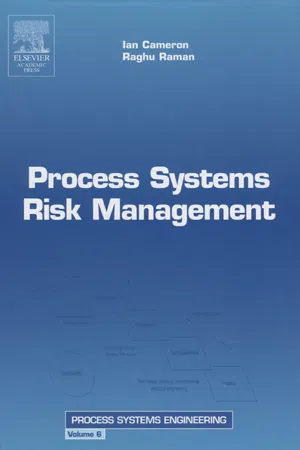![]()
Chapter 1
Managing Risks from Process Systems
“Although my commitment to the goal of immortality is unswerving, I am not positive that a zero risk society is yet in the scientific cards”
Daniel I. Koshland Jr.
Nature, 17 April 1987
A quick look through the daily newspapers shows that all human activity is surrounded by hazards and associated risks. Road accidents, disease, fires, financial collapse are all part of human existence.
In personal affairs, we tend to manage risks implicitly. In a visit to the local grocery store on foot, we tend to avoid high traffic routes, cross roads at traffic lights or pedestrian crossings to minimize risk of injury or death. When it comes to managing risks to stakeholders in an enterprise, more formal and explicit measures are required.
Risk management has been practised for millennia in all areas of human activity. The earliest concept of loss prevention was self-defence to save one’s possessions and property against attacks by enemy tribes. Since the industrial revolution, and in the aftermath of industrial disasters costing multiple lives, there has been a gradual, though not necessarily systematic improvement in work place safety. With the advent of major public companies in the 20th century and the depression of the 1930s, the need for financial risk management and protection of shareholders’ interests has evolved as a separate field of study.
In the meantime, the insurance industry has been engaged in risk management in its own way. The focus has been largely on minimising losses in the aftermath of an accident event, and hence reducing the magnitude of claims by policy holders, rather than proactive prevention of loss incidents. Industries have also come to realise that an insurance policy is not a panacea against loss events, as the policy would not compensate for the full extent of the loss. For instance, in a major fire resulting in loss of assets, the insurance policy may replace the assets, but not the loss of market share due to prolonged downtime.
With the rapid development of modern technology, the level of complexity in industrial activities increased in the latter half of the 20th century. Correspondingly, the scale of loss events has increased, as has the extent to which they can affect not only the industrial facility and its employees, but also the surrounding local population. Classic examples are the chemical factory explosion at Flixborough in England (1974); the Three Mile Island (1979) and Chernobyl (1986) incidents involving nuclear power generation plants; the major gas explosion in Mexico City (1984) with loss of hundreds of lives; the major toxic gas release at Bhopal, India (1984) resulting in loss of lives and injuries running into thousands and the Piper Alpha oil platform disaster in the North Sea (1988). It is not surprising that most of the major industrial accidents were in process facilities, due to the hazardous properties of materials stored and handled.
Each major incident prompted the legislators to tighten up safety regulations, the insurers to seek more informed risk management techniques, and the industry to adopt formal risk management systems as part of ensuring operational integrity in day-to-day operations. Thus the subject of risk management has been steadily gaining prominence in the last 25 years.
1.1 Why Risk Management?
There are many reasons why the technical and operational risks in an organisation must be assessed systematically.
1.1.1 Regulatory Requirements
Regulations covering the various aspects of risks from process operations exist in all industrialised countries and most developing countries covering the various aspects of risks from process operations. Regulatory compliance requires a dedicated organisational structure to undertake risk assessment and management to protect the health and safety of employees and the public, and the biophysical environment.
1.1.2 Common Law Duty of Care
In addition to complying with the statutory regulations, there is the all-embracing ‘duty of care’ on the part of the corporation, to protect the health and safety of its employees and the public from the corporation’s activities.
The requirement is on the organisation to demonstrate that all reasonable care has been taken in identifying the hazards associated with the facility and its operations, and that adequate hazard control measures have been put in place.
Where the duty of care has not been visibly demonstrated, there is potential for criminal liability on the part of the company, should an incident occur resulting in serious injury or fatality to employees or the public, as a result of the activities of the company.
1.1.3 Commercial Reasons
There are strong commercial reasons for minimising business interruptions and equipment damage. Systematic risk management not only identifies the hazards, but also helps to rank the allocation of resources in a cost and time effective manner. Such an approach also assists in minimising the organisation’s overall costs.
Example 1-1: Gas Production A gas producer has contracted to supply natural gas to a distributor at a high availability. This is generally an onerous task, as a major incident in the gas production facility can interrupt gas supply for extended periods.
In September 1998, an explosion occurred at the gas processing pl...
